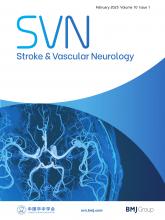Article Information
PubMed
Print ISSN
Online ISSN
History
- Received May 4, 2024
- Accepted November 2, 2024
- Published online December 25, 2024.
Article Versions
- Previous version (November 20, 2024 - 21:01).
- You are viewing the most recent version of this article.
Copyright & Usage
© Author(s) (or their employer(s)) 2024. Re-use permitted under CC BY. Published by BMJ. https://creativecommons.org/licenses/by/4.0/This is an open access article distributed in accordance with the Creative Commons Attribution 4.0 Unported (CC BY 4.0) license, which permits others to copy, redistribute, remix, transform and build upon this work for any purpose, provided the original work is properly cited, a link to the licence is given, and indication of whether changes were made. See: https://creativecommons.org/licenses/by/4.0/.
Author Information
- Alessandro Fontanella1,
- Wenwen Li2,
- Grant Mair2,
- Antreas Antoniou1,
- Eleanor Platt1,
- Paul Armitage3,
- Emanuele Trucco4,
- Joanna M Wardlaw2,5,
- Amos Storkey1
- 1The University of Edinburgh School of Informatics, Edinburgh, UK
- 2The University of Edinburgh Centre for Clinical Brain Sciences, Edinburgh, UK
- 3The University of Sheffield School of Medicine and Biomedical Sciences, Sheffield, Sheffield, UK
- 4University of Dundee School of Science and Engineering, Dundee, UK
- 5UK Dementia Research Institute, Edinburgh, UK
- Correspondence to Alessandro Fontanella; A.Fontanella{at}sms.ed.ac.uk






